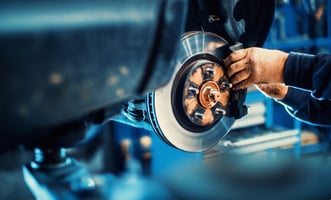 Auto mechanics and repair technicians are exposed to many hazards in their jobs. This includes slips and falls, particles in the eye, cuts, and burns from hot car parts. One of the most serious hazards, however, is often overlooked. This is exposure to friable asbestos from friction wear of brake pads/shoes and internal clutch parts. Aftermarket parts often manufactured overseas typically contain higher asbestos content, along with older model vehicle parts or used parts obtained from auto salvage yards.
Auto mechanics and repair technicians are exposed to many hazards in their jobs. This includes slips and falls, particles in the eye, cuts, and burns from hot car parts. One of the most serious hazards, however, is often overlooked. This is exposure to friable asbestos from friction wear of brake pads/shoes and internal clutch parts. Aftermarket parts often manufactured overseas typically contain higher asbestos content, along with older model vehicle parts or used parts obtained from auto salvage yards.
Wear due to friction creates a fine dust and, contrary to popular belief, brake pads and clutch parts still contain varying amounts of asbestos due to the superior heat resistance qualities. The asbestos in new brake or clutch parts is safe as it’s in an encapsulated form; however, friction wear of the part over time creates the fine dust and friable asbestos hazard.
When an auto mechanic or brake technician opens clutch housings or removes the wheel to service or replace brake pads, calipers, or rotors, they’re exposed to this dust. The dust is also present on brake parts, such as rotors and drums, which are often handled to be machined. Not only is this a respiratory hazard, small fibers on workers’ hands and exposed skin and clothing can be inadvertently ingested and even brought home to expose family members.
The workers must be properly trained and assume that all wearable pads, shoes, and clutch parts contain asbestos since it’s very difficult to distinguish between non-asbestos and asbestos parts. Workers should NEVER use the old practice of blowing the dust with compressed air as this puts the small asbestos fibers into the air and they breathe them into their lungs. They also should not use standard shop vacuums, as particles are too fine to be properly captured and controlled, nor should they wipe down parts with a dry rag or brush off the dust. Even using a wet brake clean solvent or water, if under pressure, can cause particles to become airborne. Once the particles are imbedded in the lungs, they can cause mesothelioma, asbestosis, and lung cancer years, and even decades, after exposure.
Best practices for control of asbestos in the auto repair shop environment include using a negative-pressure HEPA vacuum system to capture the dust inside the brake or clutch assembly. Low Pressure Wet Cleaning is also acceptable using equipment that has low pressure delivery of brake cleaning solvents or water mist and catches the contaminated liquid in a special basin. For do-it-yourselfers or low-volume shops, doing fewer than five brake or clutch repair jobs per week, use an aerosol spray or spray bottle of water solution. Once wet, parts can then be wiped down with a cloth to remove any remaining asbestos dust.
The closing message is that do-it–yourselfers should consider having their auto brake and repair work done in a professional shop to eliminate their exposure to asbestos. Auto repair mechanics and brake technicians should use proper handling and cleaning practices to capture and remove the asbestos before starting repair and wear respiratory personal protective equipment to further reduce your exposure.




